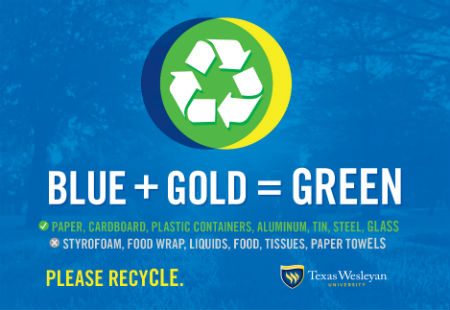'Blue+Gold=Green' campaign encourages recycling

Being Smaller, living smarter
Have you noticed the Blue + Gold=Green signs in front of recycling bins around campus? Texas Wesleyan University is encouraging students, staff and faculty across campus to be smaller and live smarter, referring to our carbon footprint. By placing recycling bins across campus, the university has now provided a place of disposal for paper, cardboard, plastic containers, aluminum, tin, steel, and glass.
"Recycling is a great way to lower our campus carbon footprint,” Jimmy Gresham, director of facilities operations, said. “Through utility conservation and energy savings projects between 2016 and 2017, we have lowered our university carbon footprint by 436 tons. That is the equivalent of taking 85 passenger cars off the road for a year. I can't wait to see how much recycling will further lower our carbon emissions."
Lids For Kids
There are many different campaigns supporting and encouraging recycling, and one is especially close to Texas Wesleyan student Tahlor Stefek's heart. Stefek learned about "Lids for Kids" when her little brother was in the hospital fighting his battle with cancer. "Lids for Kids" is a campaign put on by the American Cancer Society that encourages people to collect one full liter of plastic lids, which then gives a child a free chemo treatment. For more information about how to get involved with this campaign contact Stefek at tastefek@txwes.edu.
10 Reasons to Recycle:
- The average person generates over four pounds of trash every day.
- Americans throw away 2.5 million plastic bottles every hour.
- Every three months, Americans throw enough aluminum in the landfill to fill our nations entire commercial fleet.
- The average person has the opportunity to recycle more than 25,000 cans in a lifetime.
- Recycling a single aluminum can saves enough energy to power a TV for three hours.
- It requires 95 percent less energy and water to recycle a can than it does to create a can from virgin materials.
- When U.S. recycling levels reach 75 percent, it will be the environmental and CO2 equivalent of removing 55 million cars from U.S. roads each year.
- Half a million trees have to be cut down just to produce the Sunday newspapers each week.
- Recycling a single days worth of the New York Times could save 75,000 trees or more.
- If we recycled all newspapers, we could save over 250 million trees each and every year.
For more information on reasons to recycle, visit http://www.socrra.org/recycling_top10.shtml
Cover your footprint
A few basic tips to ensure you are doing your duty to recycle:
- Reduce, reuse, and recycle
- Know what you can and can't recycle
- Buy recycled goods
- Donate to charities rather than throw away







